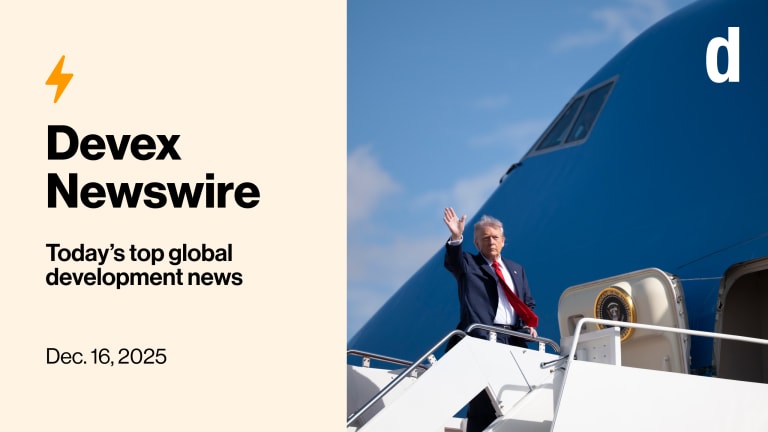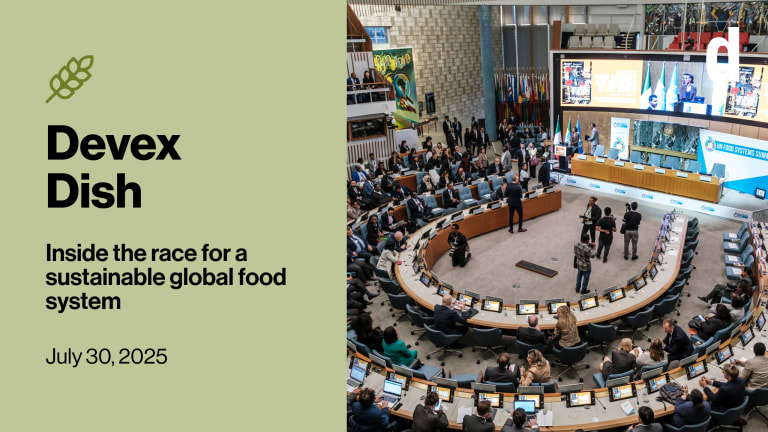
A belated happy Earth Day, Dish readers. While many of the 54 previous Earth Days have been marked by pledges, parades, and glossy reports on sustainability, the 55th arrived with anxiety.
For days, the climate and philanthropy world has been bracing for an executive order (or potentially multiple orders) from U.S. President Donald Trump that could revoke the tax-exempt status of nonprofits and foundations working on climate change, immigration, or international issues — a move that could rock global philanthropy.
Donations to groups that have tax-exempt status, known as 501(c)(3) under the U.S. tax code, are considered charitable and are tax-deductible — so losing that status would pose a major barrier to fundraising. Among the groups working on climate change and food systems transformation are the Gates Foundation, Rockefeller Foundation, and Bezos Earth Fund.
Speculation about the orders comes after the Trump administration’s dismantling of the U.S. Agency for International Development, once a $40 billion-per-year agency — and many are starting to turn to philanthropies to increase their giving and fill some of the gap.
No executive order has landed yet, but some organizations aren’t taking chances. A Gates Foundation–affiliated charity has already stripped “climate” from its programming and is shifting money overseas, my colleague Jesse Chase-Lubitz reports. Others are delaying climate initiatives or preparing to fight. “Terrifying on any level,” one insider tells Devex. “But particularly terrifying when you’re talking about the survival of our community.”
It’s now also unclear whether an order will come at all. Yesterday, a White House official told Politico that “No such orders are being drafted or considered at this time.” We’re still watching this space. Got any tips? Email me at ayenat.mersie@devex.com.
Read: Philanthropies fear Trump will target their tax-exempt status
Related reading: As aid dwindles, can philanthropy rewrite the rules of giving? (Pro)
+ Not yet a Devex Pro member? Start your 15-day free trial today to access all our exclusive reporting and analyses, data-driven funding insights, members-only events, the world’s largest global development job board, and more. Check out all the exclusive content and events available to you.
Not stirring the pot
World Bank President Ajay Banga is trying to thread the needle this week: Uphold the bank’s climate finance targets while avoiding a political firestorm from Washington.
At the Spring Meetings in Washington, D.C., the bank is keeping a lower profile — especially on topics the U.S. may find divisive, such as climate — as the Trump administration undergoes its 180-day review of U.S. involvement in international institutions. With the U.S. as the World Bank’s largest shareholder, bank officials are cautious.
Still, Banga is pressing ahead. He defended the bank’s plan to devote 45% of annual lending to climate-related projects this year, saying it doesn’t come at the expense of core development goals. “The words might be a problem in different people’s eyes,” Banga told reporters, “but … we are not taking away from education and schools and development to fund something.”
Under his leadership, the bank has embraced tools such as climate-resilient debt clauses and promoted renewable energy, precision agriculture, and carbon capture. It’s also stuck to terms such as “climate change” and “climate finance” — despite efforts by the Trump administration to strike them from any institution the U.S. funds.
Meanwhile, a coalition of climate and animal-rights advocates say the bank’s climate ambitions don’t go far enough. A new analysis by Stop Financing Factory Farming found that the International Finance Corporation, the bank’s private-sector arm, failed to enforce its own climate rules on nearly $2 billion in loans to industrial animal agriculture companies, calling the financing “a colossal waste of public finance.”
And big questions remain: Will the U.S. follow through on its $4 billion pledge to the International Development Association, the bank’s fund for the poorest countries? Will it stay engaged at all? Few expect a full withdrawal from the bank, but the uncertainty is rattling development finance.
Read: What to know as the 2025 World Bank-IMF Spring Meetings kick off
See also: World Bank’s Ajay Banga defends climate strategy ahead of Spring Meetings
Can AI predict hunger?
The Trump administration’s dismantling of USAID has shut down FEWS NET, an important hunger crisis forecasting tool, and harmed the data-gathering capabilities of the Integrated Food Security Phase Classification, or IPC. That has placed a spotlight on how artificial intelligence might plug the gaps.
Yanyan Liu, a senior researcher at the International Food Policy Research Institute, is among those leading the charge. Her AI-based model pulls in data from a wide range of sources — food prices, soil pH, satellite-tracked weather patterns, and conflict indicators from the Armed Conflict Location & Event Data project — and uses machine learning to forecast the severity of hunger up to a year in advance. The tool has shown impressive early results: It correctly identified 94.1% of severe food insecurity cases and was able to predict nearly 78% of such cases within three to 12 months.
The presence of conflict is a particularly important input. The model found that a 10% increase in conflict intensity increases the chance of vulnerable populations falling into humanitarian crisis levels of hunger by 31%. “We are not trying to replace IPC or FEWS NET,” Liu says. “But we can say that our model, this method, is complementary.”
The World Food Programme, Intergovernmental Authority on Development (with support from Google), and several universities are also developing similar tools. Nicholas Haan of IPC says his team is tracking about a dozen efforts globally, describing the surge as an “explosion” — and one that’s expected, given the tech and funding dynamics.
Still, Haan warns, “The risk is that models get things wrong. The risk is that decision makers don’t understand the models.” But with the right validation, he says, AI could help fill the void — faster, cheaper, and more strategically than ever.
Read: As famine data dries up, can AI step in?
Further reading: After decades of progress, USAID cuts could blind the world to famine
USAID out, State in
Meanwhile, the clamor to figure out what happens post-USAID continues — and the U.S. State Department has now unveiled a sweeping reorganization plan that offers a clearer view.
U.S. Secretary of State Marco Rubio announced a blueprint yesterday for what he called an “America First State Department,” one that drastically shrinks the agency and shifts foreign aid decision-making to regional diplomatic bureaus. A new Office of the Coordinator of Foreign and Humanitarian Affairs — to be called the F bureau, just like its predecessor — will handle high-level coordination. But much of what USAID used to do will now fall to diplomats, not development experts.
Critics warn that the plan could gut U.S. foreign aid as we know it. “From a foreign assistance point of view, it is an abomination,” says Rob Jenkins, a former senior USAID official. USAID’s highly technical work — from disaster risk reduction to civil society strengthening — may not survive the transition, many fear.
In an earlier reorganization plan, the State Department’s offices of Global Health Security and Diplomacy and Global Food Security — both of which still exist on the latest blueprint — were slated to take on some of USAID’s programming, while USAID’s remaining humanitarian work had been folded into the Office of Global Food Security, my colleague Elissa Miolene writes. But in the latest plan, both of those offices fall under the Under Secretary for Economic Growth, Energy and Environment — not the F bureau — and there’s no indication the State Department will still bring remaining USAID programming under its roof.
In the midst of this upheaval, Devex obtained internal USAID documents showing what kinds of global health programs the agency still considers “in” and which ones are now “out.” Among the programs that have survived are some that integrate nutrition into direct service delivery, reports my colleague Sara Jerving. For instance, the U.S. President’s Malaria Initiative REACH project includes maternal and child health and nutrition — but only when linked to malaria. Similarly, ACHIEVE, a program for pregnant women and children living with HIV, offers nutritional support as part of integrated case management. These efforts are safe — for now — but broader nutrition and food systems work not tied to direct clinical care appears to be deprioritized.
Read: State Department releases new ‘America First’ reorganization plan
See also: ‘What’s in’ and ‘what’s out’ in USAID’s global health programming
Number munching
40%
—That’s the share of African youth who spend more than a quarter of their income on accessing clean water, according to the latest Africa Youth Survey by the Ichikowitz Foundation.
Water scarcity is a major concern — 76% of youth across 17 surveyed countries worry about it, with South Africa leading at 91%. The country ranks as the 22nd most water-stressed in the world.
Climate action is also top of mind: Nearly 4 in 5 African youth say their governments need to do more to tackle climate change.
Chew on this
Bringing home the bacon
Your next job?
Agriculture Research Analyst, China Food and Nature Resources Program
World Resources Institute
China
The World Food Programme has suspended shipments to Houthi-held parts of Yemen after rebels seized one of its warehouses, sparking concerns of deepening hunger in already vulnerable areas. [AP]
In Sudan, where civil war has driven over half the population into acute hunger, Trump’s foreign aid cuts are worsening an already staggering humanitarian catastrophe. [New York Times]
Trump-era diversity restrictions and frozen grants have derailed vital food security and climate research at one of the United States’ top agricultural universities. [Reuters]
Indonesia’s plan to cultivate rice and sugar cane across vast tracts of Papua has triggered alarm among environmentalists, who warn the project could become the world’s largest deforestation effort. [AFP via Barron’s]








